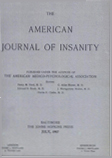"SHAM RAGE" IN MAN
Abstract
1. The literature relative to "sham rage" is reviewed.
2. Two cases of "sham rage" in human beings are presented; one following insulin hypoglycemia, the other following carbon monoxide poisoning. In both cases, the involvement of higher centers is stressed, and the resultant "sham rage" is believed to be the result of uninhibited hypothalamic discharge.
3. The expression of emotion does not necessarily mean that the individual is experiencing that emotion.
4. There seems to be no reason for accepting the idea that the hypothalamus is the "emotional center" of the body. Affects and emotions are highly complicated psychosomatic processes, which require among other things a functioning cerebral cortex.
Access content
To read the fulltext, please use one of the options below to sign in or purchase access.- Personal login
- Institutional Login
- Sign in via OpenAthens
- Register for access
-
Please login/register if you wish to pair your device and check access availability.
Not a subscriber?
PsychiatryOnline subscription options offer access to the DSM-5 library, books, journals, CME, and patient resources. This all-in-one virtual library provides psychiatrists and mental health professionals with key resources for diagnosis, treatment, research, and professional development.
Need more help? PsychiatryOnline Customer Service may be reached by emailing [email protected] or by calling 800-368-5777 (in the U.S.) or 703-907-7322 (outside the U.S.).



